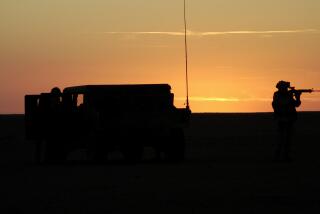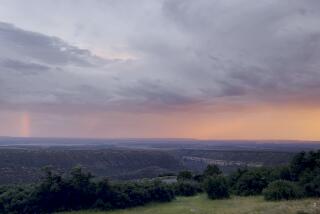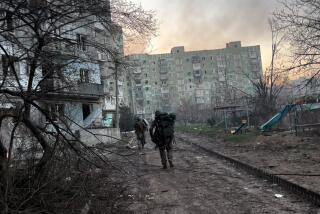A Rocky Route to Baghdad for Some Soldiers
NORTH OF BAGHDAD â The soldiers of the 4th Infantry Division received a much-needed and entirely unexpected treat when, after months of waiting, their convoy finally reached Baghdad: the sight of a Toyota filled with eight gleeful Iraqis, all waving and cheering.
Then came thousands of other Iraqis, in cars and alongside the road, who hailed the U.S. Army troops as the Humvees passed through the city.
The soldiers had missed most of the war after Turkey denied their division passage into northern Iraq from Turkish soil. Their convoy, which planners had predicted would take 18 hours to reach the Iraqi capital from Kuwait, had been on the road for more than 30 hours, with many more to go. Some of the men had been awake for 40 or 50 hours. They finally arrived in Baghdad Thursday night. With members of the Armyâs 3rd Infantry and 101st Airborne divisions and U.S. Marines camping in Saddam Husseinâs palaces and basking in the limelight of victory, the soldiers of the 4th Infantry Division were on their way to begin the thankless, dangerous job of rooting out snipers and keeping the peace.
As the battered Toyota passed, Sgt. Gary Vincent, a reserved 35-year-old, allowed himself a smile and a return wave. âNobodyâs going to tell me these people arenât happy to see us,â he said.
Unknown to the soldiers, however, some residents of Baghdad were gathered a few miles away for a protest against the U.S. militaryâs continued and growing presence in their country.
*
Rush Hour in Baghdad
With the heavy fighting weeks past now, the military continues to pour troops into Iraq, many of them driving through the heart of Baghdad with hundreds of tanks, armored vehicles and heavy weapons.
âGoing through Baghdad is the best way to the north,â Maj. John Dill of the divisionâs 3rd Battalion, 29th Field Artillery Regiment, said before his Kuwait-based troops started moving.
It is also a way to put Hussein loyalists on notice that allied forces have more firepower in the country now than when the war began and to reassure the populace that more troops and equipment are arriving to help stabilize the nation.
The convoys of the 4th Infantry Division and attached units began moving into Iraq more than a week ago and will continue marching north out of Kuwait for at least two weeks, bringing about 34,000 soldiers in 6,000 vehicles. Many of the units are heading for cities in northern Iraq, including Kirkuk, Mosul and Tikrit, where relatively few troops are now in place to make security sweeps, clear bunkers and buildings and temper animosities among ethnic groups. Others will relieve the weary and grieving soldiers of the units that fought the heavy battles.
Even without serious attacks on most of the convoys so far -- although some have been ambushed or targeted by snipers or militiamen with rocket-propelled grenades -- the treks of as far as 600 miles can prove to be grueling and frustrating tests of wartime logistics.
In an attempt to reduce wear, most tracked vehicles such as tanks are being transported on heavy equipment transports, or HETs. With a limited number of HETs, however, troops in Kuwait endure 115-degree temperatures and sandstorms as their departures are delayed.
The heavily laden Humvee carrying 1st Sgt. Scott Haig of the 3rd Battalion pulled out at 8:40 a.m. Wednesday, several days after the convoy had expected to depart and 2 hours and 40 minutes after the final, final go-time. Just nine miles down the road, before it had even crossed into Iraq, the Humvee blew its right front tire.
The tire was a cheap retread. Haig and his three soldiers could not find a spare among hundreds of other Humvees and supply trucks making the trip to the so-called attack point nearly 400 miles north. For the proud soldiers, this became the most depressing problem on a journey full of difficulties -- gunfire, unexploded ordnance and mines on the side of the road, exhaustion. They had to be towed to the battlefield, in a war that was mostly over.
âIâm going to hear about this the rest of my career,â Haig said.
The convoys are broken into separate travel units of about 25 vehicles, but with so many troops and supplies on the road, they often appear to be a single group, trucks and tanks stretched along the route as far as the eye can see.
Trying to keep the convoys moving -- thus making them more difficult targets -- commanders are ordered never to turn back to aid one of their own vehicles. If a truck breaks down, its crew dismounts and assumes security duties until mechanics or tow vehicles from a following convoy arrive. If a driver is killed, the person in the seat next to him or her takes the wheel.
âThe convoy does not slow down for anything,â one captain announced before the vehicles moved out.
Haigâs crippled Humvee nonetheless stopped a dozen times as the soldiers aided faltering vehicles from another convoy. It also stopped when the road was clogged with other convoys. Some of the stops took hours, and Haig and his men stood guard, weapons at the ready, until it was time to move.
Because the 4th Infantry was supposed to ship out in early February, it had loaded its equipment onto more than 30 cargo ships in January. The ships floated around the Mediterranean as Turkeyâs parliament debated whether to allow U.S. troops to stage an incursion from Turkish territory. The idea was rejected.
By the time the soldiers flew to Kuwait in late March and early this month, and the ships passed through the Suez Canal and into the Persian Gulf, the dozens of Paladin tracked artillery cannons, hundreds of Abrams M-1A1 tanks and Bradley fighting vehicles, and thousands of Humvees and other vehicles had been sitting in the salty sea air for longer than two months.
Because the division was late getting to the region, soldiers had just a week or two to find and fix their vehicles -- often bartering for, âborrowingâ or rigging up spare parts. They also had to check and repair their heavy guns and radios, as well as locate and load ammunition, water, food and sleeping bags.
During the 4th Infantry Divisionâs initial forays north, children attempted to halt trucks by standing in front of them while their friends tore at duffel bags, boxes of bottled water and even ammunition that had been strapped to the outside. When the next convoys kept the children away with sticks, the kids came back with 10-foot-long poles with knives on the end, cutting the straps that held supplies and making off with the loot.
In this convoy, many of the soldiers have fixed their bayonets to the end of their assault weapons, and the glint of sun on stainless steel helps to keep the children at bay.
âMan, what now?â Sgt. Craig Fast, 23, said as his Humvee came to yet another halt in south-central Iraq. Another breakdown.
Children approached. Instead of trying to loot the trucks, however, they plied a newfound trade: trying to sell items swiped from previous convoys or given to them by soldiers: Skittles from rations, goggles from an Army PX, a Stuff magazine. They also hawked Iraqi dinar notes with Husseinâs image, going for $1.
*
Eyeing the Bystanders
The convoy arrived in Baghdad at dusk. Riding in the back of their Humvee, Sgt. Vincent and Staff Sgt. Kenny Rogers began eyeing each car and bystander carefully. âItâs hard to look dangerous when youâre being towed,â Rogers said.
They were delighted upon realizing they didnât really need to look dangerous.
Some Iraqis sneered, some simply didnât look their way, but the vast majority waved and cheered, and grinned when the soldiers waved back.
The trip to the attack point, just 20 miles from the city, took six more hours. Everyone was exhausted but happy.
âThereâs still an important job for us here,â Rogers said. âIâm glad to finally be in Iraq.â
More to Read
Sign up for Essential California
The most important California stories and recommendations in your inbox every morning.
You may occasionally receive promotional content from the Los Angeles Times.










